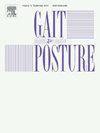评估运动员跳跃任务中神经认知负荷对躯干变异性的影响
IF 2.2
3区 医学
Q3 NEUROSCIENCES
引用次数: 0
摘要
本研究的目的是评估神经认知负荷对跳跃任务运动变异性和结果的影响。方法18名休闲运动员和18名NCAA一级运动员在没有和存在神经认知负荷的情况下进行了32次成功的跳跃试验。一个12摄像机无标记运动分析系统记录了跳跃试验。根据有无神经认知负荷、跳跃方向和跳跃数对每一跳的主干质心(tCOM)的接触相位坐标历史进行分组,确定每一跳的正、负1标准差曲线生成集的范数。线性混合模型比较负荷条件和运动水平及其对每个任务结果的相互作用在0.05 α显著水平上。发现负荷条件或运动水平对平均tCOM跨度集跳1和2接触相规范的影响不存在(p >; .0.05)。tCOM的可变性似乎不受运动水平或神经认知负荷的影响,这可能表明tCOM是神经肌肉系统试图控制的一个关键变量。运动员所处的环境的风险和压力源应该被提高,以确保神经系统在安全和成功之间保持平衡。本文章由计算机程序翻译,如有差异,请以英文原文为准。
Assessing the impact of neurocognitive load on trunk variability in athletes during a hopping task
Background
This study’s purpose was to evaluate the effect of a neurocognitive load on hop task movement variability and outcome.
Methods
Eighteen recreational and 18 NCAA Division 1 athletes performed 32 successful hopping trials in the absence and presence of a neurocognitive load. A 12-camera markerless motion analysis system recorded the hopping trials. The contact phase coordinate histories of the center of mass of the trunk (tCOM) of each hop were grouped according to presence or absence of neurocognitive load, hop direction, and hop number and the norm of the spanning set of the plus and minus 1 standard deviation curves were determined for each subject. Linear mixed models compared the load condition and athletic level and their interaction for each task outcome at a 0.05 alpha significance level.
Findings
An effect of load condition or athletic level was not present (p > .0.05) on the mean tCOM span set hop 1 or 2 contact phase norms. The tCOM variability does not appear to be affected by athletic level or neurocognitive load potentially indicating that tCOM is a key variable the neuromuscular system is attempting to control.
Interpretations
The stakes and stressors of the environment in which the athlete is being tasked with performing in should be heightened to ensure the nervous system is practicing the balance between safety and success.
求助全文
通过发布文献求助,成功后即可免费获取论文全文。
去求助
来源期刊

Gait & posture
医学-神经科学
CiteScore
4.70
自引率
12.50%
发文量
616
审稿时长
6 months
期刊介绍:
Gait & Posture is a vehicle for the publication of up-to-date basic and clinical research on all aspects of locomotion and balance.
The topics covered include: Techniques for the measurement of gait and posture, and the standardization of results presentation; Studies of normal and pathological gait; Treatment of gait and postural abnormalities; Biomechanical and theoretical approaches to gait and posture; Mathematical models of joint and muscle mechanics; Neurological and musculoskeletal function in gait and posture; The evolution of upright posture and bipedal locomotion; Adaptations of carrying loads, walking on uneven surfaces, climbing stairs etc; spinal biomechanics only if they are directly related to gait and/or posture and are of general interest to our readers; The effect of aging and development on gait and posture; Psychological and cultural aspects of gait; Patient education.
 求助内容:
求助内容: 应助结果提醒方式:
应助结果提醒方式:


